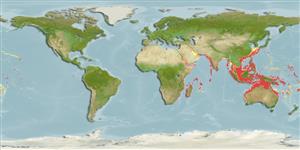分類 / Names
俗名 | 同種異名 | Catalog of Fishes(屬, 種) | ITIS | CoL | WoRMS | Cloffa
Elasmobranchii
板鰓亞綱 (鯊魚與魟魚) (sharks and rays) >
Myliobatiformes (Stingrays)
鰩目 (Stingrays) >
Dasyatidae (Stingrays)
土魟科 (Stingrays) > Neotrygoninae
Etymology: More on authors: Müller & Henle.
Issue
Formerly a widespread species, but forms a species complex with three other species. Information (data from references) collated undergoing modifications (in progress).
Environment: milieu / climate zone / depth range / distribution range
生態學
海洋 礁區魚類; 深度上下限 0 - 170 m (Ref. 89055), usually ? - 90 m (Ref. 9840). 熱帶; 6°S - 12°S, 156°E - 164°E
Southwest Pacific: Solomon Islands, but probably more widespread in Oceania (limits of its distribution need to be defined). Forms a species complex with Neotrygon australiae (Australia, New Guinea and eastern Indonesia), N. caeruleopunctata (Indian Ocean), and N. orientale (North-West Pacific).
印度-西太平洋: 紅海 (參考文獻 9840) ,桑吉巴 (坦尚尼亞) ,南非,印度 , 斯里蘭卡東至美屬薩摩亞 (參考文獻 592) 與東加 (參考文獻 53797),北至日本, 南至澳洲.(參考文獻 9840) 呈現出印度-太平洋的那可能是不同的種的多個色彩變種了。 (參考文獻 9840)
Length at first maturity / 大小 / 重量 / 年齡
Maturity: Lm 27.6, range 12 - 46.5 cm
Max length : 70.0 cm TL 雄魚/尚未辨別雌雄; (Ref. 5578)
This medium-sized Neotrygon of the kuhlii-complex (reaching at least 30 cm DW) is distinguished by the following set of characters: disc is broader than long, its width ca. 1.2 times length; pectoral apices are narrowly rounded; snout rather fleshy, broadly angular, its angle ca. 107°, its length 1.7-2.1 times interorbital width; maximum width is relatively well back on disc, the length from snout tip to pectoral-fin insertion 1.8-1.9 times and disc width 2.5-2.6 times horizontal distance from snout tip to maximum disc width; preoral length is 2.4-2.8 times mouth width; internasal distance is 1.5-1.8 in prenasal length; interspiracular distance is 13-15% DW; nostril length is 2.8-4.1% DW; nasal curtain width is 8-8.3% DW; mouth small, its width 6.4-6.8% DW; horizontal distance from cloaca to caudal sting base ca. 55% of disc length; nuchal region with thornlets, none from tail in all sizes; no dermal denticles; 113 pectoral-fin radials (based on new specimen); 133 total vertebral centra (including synarcual), 39 trunk centra (including synarcual); presence of blue spots that are very small and sparse, largest spot on disc 0.3-0.5 times eye width; median belt with 0-6 (mean 3.0) blue spots, largest ~2.1% DW; pronounced mask-like marking, not covered with dark peppery spots; ventral surface of disc and pelvic fins with broad dark greyish submarginal bands; when fresh, ventral tail fold and adjacent tail bluish grey (Ref. 116741).
紅褐色的有藍色的背面集中明亮的假眼斑與分散的黑色斑點, 腹側白色的.(參考文獻 3263) 吻非常短與寬廣有角; 體盤有角的; 尾巴與身體等長有明顯的黑白環, 而且具有一個短的上尾部的鰭褶但是一個更長的低一個終止在尾部頂端正後方; 體盤沒有刺; 通常在尾部上的一個刺.(參考文獻 5578)
A solitary species found on sandy bottoms near rocky or coral reefs (Ref. 12951). Usually found in deeper water but moves onto the reef flat and into shallow lagoons at high tide (Ref. 12951). Occasionally covers itself with sand, leaving only its eyes and tail visible (Ref. 37816). Feeds on crabs and shrimps (Ref. 5578). Ovoviviparous (Ref. 50449). The venomous spine can inflict a painful wound (Ref.4690). Caught in very large quantities in the bottom trawl, trammel and fish trap fisheries. Utilized for its meat but of limited value due to its small size (Ref. 58048). It is parasitised by the monogenean Dendromonocotyle kuhlii on the dorsal skin surface (Ref. 124051).
一種獨居性種發現於在岩礁或珊瑚礁附近的砂質底部了。 (參考文獻 12951) 通常發現於較深的水域但是移動到礁石平臺上與進入潟湖淺灘之內在漲潮時.(參考文獻 12951) 偶然地以被僅留下它的眼睛與尾巴的沙子覆蓋它本身看得見的.(參考文獻 37816) 吃螃蟹與蝦。 (參考文獻 5578) 卵胎生的.(參考文獻 50449) 有毒的棘能施放令人痛苦的創傷。
Exhibit ovoviparity (aplacental viviparity), with embryos feeding initially on yolk, then receiving additional nourishment from the mother by indirect absorption of uterine fluid enriched with mucus, fat or protein through specialised structures (Ref. 50449). Distinct pairing with embrace (Ref. 205). Litters size at birth 16 cm (Ref. 37816); Java form born at 11-16 cm WD, Bali form born at ~17 cm WD. Gives birth to litters of 1-2 pups; no reproductive synchronicity (Ref. 58048).印度-西太平洋: 紅海 (參考文獻 9840) ,桑吉巴 (坦尚尼亞) ,南非,印度 , 斯里蘭卡東至美屬薩摩亞 (參考文獻 592) 與東加 (參考文獻 53797),北至日本, 南至澳洲.(參考文獻 9840) 呈現出印度-太平洋的那可能是不同的種的多個色彩變種了。 (參考文獻 9840)
Last, P.R., White, W.T. and B. Séret, 2016. Taxonomic status of maskrays of the Neotrygon kuhlii species complex (Myliobatoidei: Dasyatidae) with the description of three new species from the Indo-West Pacific. Zootaxa 4083(4):533-561. (Ref. 116741)
人類使用
漁業: 商業性; 水族館: 商業性
工具
特別的報告
下載 XML
網路資源
Estimates based on models
Preferred temperature (Ref.
123201): 23.9 - 29, mean 27.8 °C (based on 2546 cells).
Phylogenetic diversity index (Ref.
82804): PD
50 = 0.5039 [Uniqueness, from 0.5 = low to 2.0 = high].
Bayesian length-weight: a=0.01096 (0.00342 - 0.03513), b=3.11 (2.86 - 3.36), in cm total length, based on LWR estimates for this (Sub)family-body shape (Ref.
93245).
營養階層 (Ref.
69278): 3.3 ±0.3 se; based on diet studies.
Generation time: 8.5 ( na - na) years. Estimated as median ln(3)/K based on 2
growth studies.
回復力 (Ref.
120179): 非常低的, 最小族群倍增時間超過14 年 (Fec=1-3).
Fishing Vulnerability (Ref.
59153): Moderate to high vulnerability (52 of 100).
Nutrients (Ref.
124155): Calcium = 14.2 [3.0, 58.7] mg/100g; Iron = 0.446 [0.109, 1.168] mg/100g; Protein = 22.2 [19.3, 25.3] %; Omega3 = 0.117 [0.035, 0.325] g/100g; Selenium = 32.2 [8.9, 82.3] μg/100g; VitaminA = 57.4 [22.8, 143.3] μg/100g; Zinc = 0.977 [0.477, 1.924] mg/100g (wet weight);
